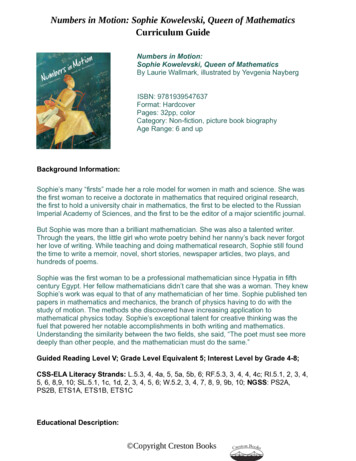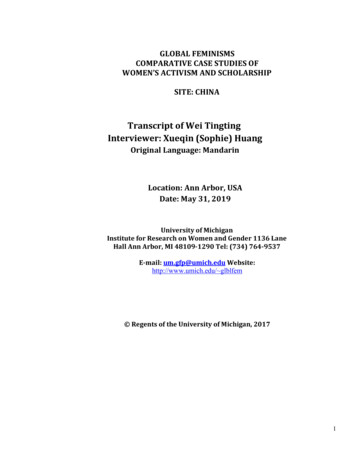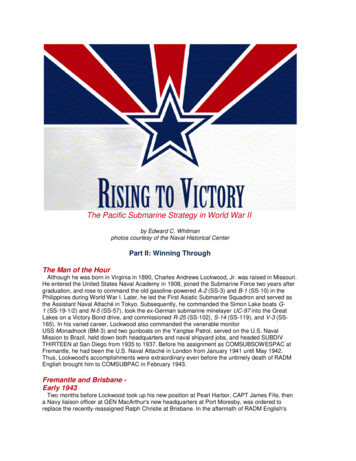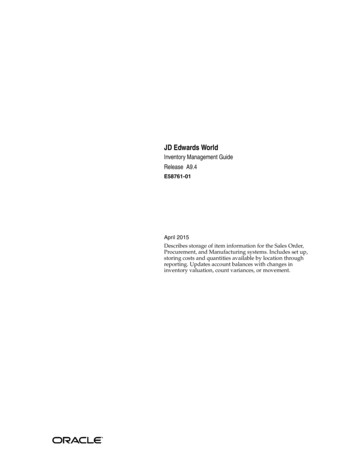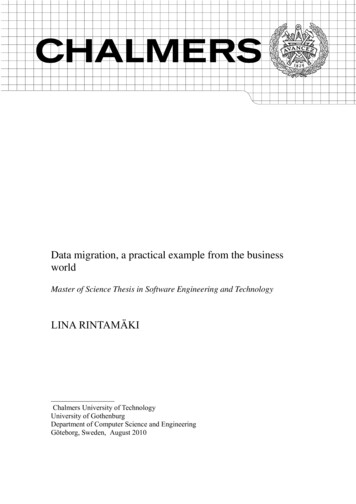
Transcription
Sophie’s WorldJostien GaarderReviews:More praise for the international bestseller that has become “Europe’s oddballliterary sensation of the decade”(New York Newsday)“A page-turner.” —Entertainment Weekly“First, think of a beginner’s guide to philosophy, written by a schoolteacher .Next, imagine a fantasy novel— something like a modern-day version of Through theLooking Glass. Meld these disparate genres, and what do you get? Well, what you getis an improbable international bestseller . a runaway hit. [a] tour deforce.”—Time“Compelling.” —Los Angeles Times“Its depth of learning, its intelligence and its totally original conception give itenormous magnetic appeal . To be fully human, and to feel our continuity with 3,000years of philosophical inquiry, we need to put ourselves in Sophie’s world.” —BostonSunday Globe“Involving and often humorous.” —USA Today“In the adroit hands of Jostein Gaarder, the whole sweep of three millennia ofWestern philosophy is rendered as lively as a gossip column . Literary sorcery of thefirst rank.” —Fort Worth Star-Telegram“A comprehensive history of Western philosophy as recounted to a 14-year-oldNorwegian schoolgirl. The book will serve as a first-rate introduction to anyone whonever took an introductory philosophy course, and as a pleasant refresher for thosewho have and have forgotten most of it. [Sophie’s mother] is a marvelous comicfoil.” —Newsweek“Terrifically entertaining and imaginative . I’ll read Sophie’s World again.” —Daily Mail“What is admirable in the novel is the utter unpretentious-ness of thephilosophical lessons, the plain and workmanlike prose which manages to deliverWestern philosophy in accounts that are crystal clear. It is heartening to know that abook subtitled“’A Novel About the History of Philosophy’ was not only a bestseller in France,but for a while Europe’s hottest novel.”—The Washington Post Book World“A rare bird indeed, a short history of Western philosophical thought fromSocrates to Sartre, coyly embedded in the wrapping of a suspense novel.” —NewYork Newsday“A simply wonderful, irresistible book . a cross between Bertrand Russell’sHistory of Western Philosophy and Alice in Wonderland.” —The Daily Telegraph“An exciting trek into, the realm of thought, from the ancient philosophers’school of Athens to the Konigsberg of Kant. and a brilliant success.” -Der Spiegel“Intelligently written. an enchanting way to learn philosophy.” —BatonRouge Magazine“Just as remarkable for its playful premise as it is for its accessibility . Theessential charm of Sophie’s World lies in the innocent curiosity of the young
character, and the clever narrative structure Gaarder designed to pique it.”—Columbus Dispatch“An extraordinary writer.” —Madeleine L’EngleSophie’s WorldA Novel About the History of PhilosophyJOSTEIN GAARDERTranslated by Paulette MillerBERKLEY BOOKS, NEW YORKIf you purchased this book without a cover, you should be aware that this bookis stolen property. It was reported as “unsold and destroyed” to the publisher, andneither the author nor the publisher has received any payment for this “strippedbook.”SOPHIE’S WORLDA Berkley Book / published by arrangement with Farrar, Straus and Giroux,Inc.PRINTING HISTORYFarrar, Straus and Giroux, Inc., edition published 1994 Berkley edition / March1996 All rights reserved.Originally published in Norwegian under the title Sofies verden, copyright 1991 by H. Aschehoug & Co. (W. Nygaard), Oslo.Translation copyright 1994 by Paulette Moller.This book may not be reproduced in whole or in part, by mimeograph or anyother means, without permission. For information address: Farrar, Straus, andGiroux, Inc., 19 Union Square West, New York, New York 10003.The Putnam Berkley World Wide Web site address is http://www.berkley.comISBN: 0-425-15225-1BERKLEY Berkley Books are published by The Berkley Publishing Group, 200 MadisonAvenue, New York, New York 10016.BERKLEY and the “B” design are trademarks belonging to Berkley PublishingCorporation.PRINTED IN THE UNITED STATES OF AMERICA 10AcknowledgmentsThis book would not have been possible without the support and encouragementof Siri Dan-nevig. Thanks are also due to Maiken Ims for reading the manuscript andmaking useful comments, and to Trond Berg Eriksen for his trenchant observationsand knowledgeable support through the years.J.G.He who cannot draw on three thousand yearsIs living from hand to mouthGOETHE
THE GARDEN OF EDEN at some point something must have come from nothing Sophie Amundsen was on her way home from school. She had walked the firstpart of the way with Joanna. They had been discussing robots. Joanna thought the human brain was like an advanced computer. Sophie was not certain she agreed. Surelya person was more than a piece of hardware?When they got to the supermarket they went their separate ways. Sophie livedon the outskirts of a sprawling suburb and had almost twice as far to school as Joanna.There were no other houses beyond her garden, which made it seem as if her houselay at the end of the world. This was where the woods began.She turned the corner into Clover Close. At the end of the road there was asharp bend, known as Captain’s Bend. People seldom went that way except on theweekend.It was early May. In some of the gardens the fruit trees were encircled withdense clusters of daffodils. The birches were already in pale green leaf.It was extraordinary how everything burst forth at this time of year! What madethis great mass of green vegetation come welling up from the dead earth as soon as itgot warm and the last traces of snow disappeared?As Sophie opened her garden gate, she looked in the mailbox. There wasusually a lot of junk mail and a few big envelopes for her mother, a pile to dump onthe kitchen table before she went up to her room to start her homework.From time to time there would be a few letters from the bank for her father, butthen he was not a normal father. Sophie’s father was the captain of a big oil tanker,and was away for most of the year. During the few weeks at a time when he was athome, he would shuffle around the house making it nice and cozy for Sophie and hermother. But when he was at sea he could seem very distant.There was only one letter in the mailbox—and it was for Sophie. The whiteenvelope read: “Sophie Amundsen, 3 Clover Close.” That was all; it did not say whoit was from. There was no stamp on it either.As soon as Sophie had closed the gate behind her she opened the envelope. Itcontained only a slip of paper no bigger than the envelope. It read: Who are you?Nothing else, only the three words, written by hand, and followed by a largequestion mark.She looked at the envelope again. The letter was definitely for her. Who couldhave dropped it in the mailbox?Sophie let herself quickly into the red house. As always, her cat Sherekanmanaged to slink out of the bushes, jump onto the front step, and slip in through thedoor before she closed it behind her.Whenever Sophie’s mother was in a bad mood, she would call the house theylived in a menagerie. A menagerie was a collection of animals. Sophie certainly hadone and was quite happy with it. It had begun with the three goldfish, Goldtop, RedRidinghood, and Black Jack. Next she got two budgerigars called Smitt and Smule,then Govinda the tortoise, and finally the marmalade cat Sherekan. They had all beengiven to her to make up for the fact that her mother never got home from work untillate in the afternoon and her father was away so much, sailing all over the world.Sophie slung her schoolbag on the floor and put a bowl of cat food out forSherekan. Then she sat down on a kitchen stool with the mysterious letter in her hand.Who are you?She had no idea. She was Sophie Amundsen, of course, but who was that? She
had not really figured that out—yet.What if she had been given a different name? Anne Knutsen, for instance.Would she then have been someone else?She suddenly remembered that Dad had originally wanted her to be calledLillemor. Sophie tried to imagine herself shaking hands and introducing herself asLillemor Amundsen, but it seemed all wrong. It was someone else who keptintroducing herself.She jumped up and went into the bathroom with the strange letter in her hand.She stood in front of the mirror and stared into her own eyes.“I am Sophie Amundsen,” she said.The girl in the mirror did not react with as much as a twitch. Whatever Sophiedid, she did exactly the same. Sophie tried to beat her reflection to it with a lightningmovement but the other girl was just as fast.“Who are you?” Sophie asked.She received no response to this either, but felt a momentary confusion as towhether it was she or her reflection who had asked the question.Sophie pressed her index finger to the nose in the mirror and said, “You areme.”As she got no answer to this, she turned the sentence around and said, “I amyou.”Sophie Amundsen was often dissatisfied with her appearance. She wasfrequently told that she had beautiful almond-shaped eyes, but that was probably justsomething people said because her nose was too small and her mouth was a bit toobig. And her ears were much too close to her eyes. Worst of all was her straight hair,which it was impossible to do anything with. Sometimes her father would stroke herhair and call her “the girl with the flaxen hair,” after a piece of music by ClaudeDebussy. It was all right for him, he was not condemned to living with this straightdark hair. Neither mousse nor styling gel had the slightest effect on Sophie’s hair.Sometimes she thought she was so ugly that she wondered if she was malformed atbirth. Her mother always went on about her difficult labor. But was that really whatdetermined how you looked?Wasn’t it odd that she didn’t know who she was? And wasn’t it unreasonablethat she hadn’t been allowed to have any say in what she would look like? Her lookshad just been dumped on her. She could choose her own friends, but she certainlyhadn’t chosen herself. She had not even chosen to be a human being.What was a human being?Sophie looked up at the girl in the mirror again.“I think I’ll go upstairs and do my biology homework,” she said, almostapologetically. Once she was out in the hall, she thought, No, I’d rather go out in thegarden.“Kitty, kitty, kitty!”Sophie chased the cat out onto the doorstep and closed the front door behindher.As she stood outside on the gravel path with the mysterious letter in her hand,the strangest feeling came over her. She felt like a doll that had suddenly been broughtto life by the wave of a magic wand.Wasn’t it extraordinary to be in the world right now, wandering around in awonderful adventure!Sherekan sprang lightly across the gravel and slid into a dense clump of redcurrant bushes. A live cat, vibrant with energy from its white whiskers to the
twitching tail at the end of its sleek body. It was here in the garden too, but hardlyaware of it in the same way as Sophie.As Sophie started to think about being alive, she began to realize that she wouldnot be alive forever. I am in the world now, she thought, but one day I shall be gone.Was there a life after death? This was another question the cat was blissfullyunaware of.It was not long since Sophie’s grandmother had died. For more than six monthsSophie had missed her every single day. How unfair that life had to end!Sophie stood on the gravel path, thinking. She tried to think extra hard aboutbeing alive so as to forget that she would not be alive forever. But it was impossible.As soon as she concentrated on being alive now, the thought of dying also came intoher mind. The same thing happened the other way around: only by conjuring up anintense feeling of one day being dead could she appreciate how terribly good it was tobe alive. It was like two sides of a coin that she kept turning over and over. And thebigger and clearer one side of the coin became, the bigger and clearer the other sidebecame too.You can’t experience being alive without realizing that you have to die, shethought. But it’s just as impossible to realize you have to die without thinking howincredibly amazing it is to be alive.Sophie remembered Granny saying something like that the day the doctor toldher she was ill. “I never realized how rich life was until now,” she said.How tragic that most people had to get ill before they understood what a gift itwas to be alive. Or else they had to find a mysterious letter in the mailbox!Perhaps she should go and see if any more letters had arrived. Sophie hurried tothe gate and looked inside the green mailbox. She was startled to find that it containedanother white envelope, exactly like the first. But the mailbox had definitely beenempty when she took the first envelope! This envelope had her name on it as well.She tore it open and fished out a note the same size as the first one.Where does the world come from? it said.I don’t know, Sophie thought. Surely nobody really knows. And yet—Sophiethought it was a fair question. For the first time in her life she felt it wasn’t right tolive in the world without at least inquiring where it came from.The mysterious letters had made Sophie’s head spin. She decided to go and sitin the den.The den was Sophie’s top secret hiding place. It was where she went when shewas terribly angry, terribly miserable, or terribly happy. Today she was simply confused.***The red house was surrounded by a large garden with lots of flowerbeds, fruitbushes, fruit trees of different kinds, a spacious lawn with a glider and a little gazebothat Granddad had built for Granny when she lost their first child a few weeks after itwas born. The child’s name was Marie. On her gravestone were the words: “LittleMarie to us came, greeted us, and left again.”Down in a corner of the garden behind all the raspberry bushes was a densethicket where neither flowers nor berries would grow. Actually, it was an old hedgethat had once marked the boundary to the woods, but becaus
Sophie’s World Jostien Gaarder Reviews: More praise for the international bestseller that has become “Europe’s oddball literary sensation of the decade”
